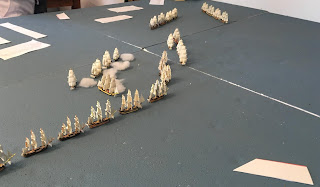The scenario came straight out of the rule book (Grand Fleet Actions in the Age of Sail). After a bit of discussion, Julian and I decided to play it 'as given', so the English commanders were rated 'average', crews 'veteran', French commanders and crews 'average' and the Spanish command 'inept' and crews 'slack'. We had seven players with Mark H ('Marc'), Mark B (Biko), Olivier and Stephen of the NWS joining Julian, Mark (Wilko) and me. I took the Spanish as the descriptions sounded fitting!
What follows is a brief, pictorial account. No doubt Julian will post one of his excellent reports of the action in full account on our Avon Napoleonic Fellowship blog and Mark H will be posting from Villeneuve's point of view (his role), so I'll add links to those in time.
(Mark H has not done this excellent post about the game)
The Allied fleet in line ahead, heading east towards Ferrol. English fleet approaching in the distance, from the north-east, also in line ahead. Wind coming from the north-west.
The historic action was fought in foggy conditions, so the commanders used 'follow the leader' to keep their fleets together. The fog was reflected in the scenario by the simple, but significant, effect of halving the command range.
The Allied fleet with Rear-Admiral Dumanoir's command (Julian) in the van.
The English broke into four groups with the aim of cutting the Allied fleet in several places and defeating it in detail. Captain Gardner (Olivier), Admiral Calder (Stephen), Rear-Admiral Stirling and Captain Butler (both Wilko), from nearest to furthest.
Dumanoir was first to come into action, inflicting some damage on Gardner's lead ships (Agamemnon and Hero (flag)).
Calder's command soon joined in the action, ...
... as Gardner's ships opened up.
An artist's impression, c/- Wikimedia Commons.
A wider view of the action around this stage (Allied at bottom-left).
Calder's ships unleashing on Dumanoir's vanguard.
At the rear of the line, my ships were oblivious to it all.
Villeneuve (Marc) came into action in fine style.
The raking shot on another of Gardner's command resulted in a test for catastrophe.
The 1 in 10 of a one,...
... ship explodes!
(Addendum to original post: I forgot to mention that this, I recall, was as a result of our local land-lubber, Wilko, successfully executing a 'Nelson's touch' manoeuvre and breaking Dumanoir's line. He's starting to get the hang of this 'boating' lark!)
Magnon de Médine (Biko) now came into action, but his crews were not as accurate as Villeneuve's, firing an ineffective rake,...
... and inflicting little further damage on what remained of Gardner's (former) hard-pressed (and demoralised) command.
Some wider photos of the action at this stage.
Same again, showing Hero sailing away in the foreground.
My rearguard finally came into action, adding to ex-Gardner's woes (a lucky '10' making up a lot for my 'slack' crews).
The table at the end of the game. At the top, in front of Calder's hat, Rear Admiral Dumanoir's former command (demoralised) and Admiral Villeneuve's command are making east and safety of Ferrol. The central line are Rear-Admiral Magnon de Médine's and Admiral Don Gravina's commands that seem destined to safely by-pass most of the English ships that are past them and against the wind: part of Captain Butler's command at top-right, Admiral Calder's closest to camera, what remains of ex-Gardner's ships at front-left and Rear-Admiral Stirling's coming in towards the line in the centre.
With 50%-plus of their ships exiting or likely to, the east table edge, it was a French scenario victory.
It was a most enjoyable game, looked and felt like a Napoleonic naval game, and all seven players got to move ships and have a shot or two (several more for those in the van and centre).
Well done and thanks Julian for hosting such an enjoyable game. The testing, checking and investment all paid off. Trafalgar beckons...!

























